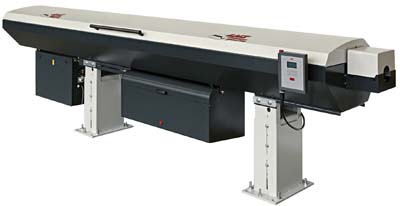
The Hydrobar Sprint 542 automatic bar loader from LNS America Inc. feeds 12' round, hexagonal or square bar stock with diameters from ¼" to 1-5⁄8" (5mm to 42mm) into fixed- or sliding-headstock turning machines. A programmable, fully automatic, hydrostatic front stabilizer dampens vibrations between the bar feed and the lathe spindle, enabling users to operate at optimal spindle speeds while maintaining cutting accuracy, according to the company. Hydrobar Sprint 542 uses round, elongated guiding elements that open for new bar loading and then close for the entire machining process. This permits hydrodynamic or hydrostatic operation in a pressurized oil film. To further enhance productivity, complete diameter changeovers take less than 8 minutes using quick-change guiding elements that require no tools, and by entering diameter, part length and application data into the prompting remote control. The machine then automatically self-adjusts to these parameters. Standard equipment includes a remnant retraction system, an automatic front stabilizer, a menu-driven, prompting remote control, and a Z-axis retraction system. It can be ordered with either a front- or rear-mounted loading ramp. The loading ramp includes automatic diameter adjustment of bar selection fingers.
Contact Details
Related Glossary Terms
- feed
feed
Rate of change of position of the tool as a whole, relative to the workpiece while cutting.
- lathe
lathe
Turning machine capable of sawing, milling, grinding, gear-cutting, drilling, reaming, boring, threading, facing, chamfering, grooving, knurling, spinning, parting, necking, taper-cutting, and cam- and eccentric-cutting, as well as step- and straight-turning. Comes in a variety of forms, ranging from manual to semiautomatic to fully automatic, with major types being engine lathes, turning and contouring lathes, turret lathes and numerical-control lathes. The engine lathe consists of a headstock and spindle, tailstock, bed, carriage (complete with apron) and cross slides. Features include gear- (speed) and feed-selector levers, toolpost, compound rest, lead screw and reversing lead screw, threading dial and rapid-traverse lever. Special lathe types include through-the-spindle, camshaft and crankshaft, brake drum and rotor, spinning and gun-barrel machines. Toolroom and bench lathes are used for precision work; the former for tool-and-die work and similar tasks, the latter for small workpieces (instruments, watches), normally without a power feed. Models are typically designated according to their “swing,” or the largest-diameter workpiece that can be rotated; bed length, or the distance between centers; and horsepower generated. See turning machine.
- turning
turning
Workpiece is held in a chuck, mounted on a face plate or secured between centers and rotated while a cutting tool, normally a single-point tool, is fed into it along its periphery or across its end or face. Takes the form of straight turning (cutting along the periphery of the workpiece); taper turning (creating a taper); step turning (turning different-size diameters on the same work); chamfering (beveling an edge or shoulder); facing (cutting on an end); turning threads (usually external but can be internal); roughing (high-volume metal removal); and finishing (final light cuts). Performed on lathes, turning centers, chucking machines, automatic screw machines and similar machines.






